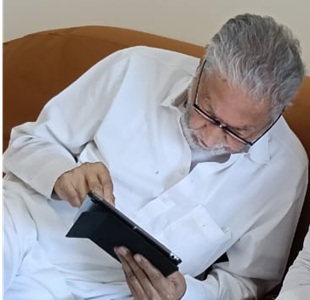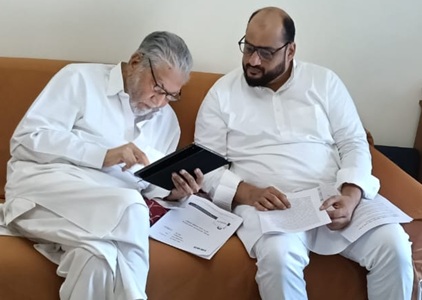By Ather Ahmed ATKINS
Sir Syed Ahmad Khan, one of the architects of modern India was born on October 17, 1817 in Delhi and started his career as a civil servant.
The 1857 revolt was one of the turning points in Syed Ahmed’s life. He clearly foresaw the imperative need for the Muslims to acquire proficiency in the English language and modern sciences, if the community were to maintain its social and political clout, particularly in Northern India.
He was one of those early pioneers who recognized the critical role of education in the empowerment of the poor and backward Muslim community. In more than one ways, Sir Syed was one of the greatest social reformers and a great national builder of modern India. He began to prepare the road map for the formation of a Muslim University by starting various schools. He instituted Scientific Society in 1863 to instill a scientific temperament into the Muslims and to make the Western knowledge available to Indians in their own language.
The Aligarh Institute Gazette, an organ of the Scientific Society, was launched in March 1866 and succeeded in agitating the minds in the traditional Muslim society. Anyone with a poor level of commitment would have backed off in the face of strong opposition but Sir Syed responded by bringing out another journal, Tehzibul Akhlaq which was rightly named in English as ‘Mohammedan Social Reformer’
In 1875, Sir Syed founded the Madarsatul Uloom in Aligarh and patterned the MAO College after Oxford and Cambridge universities that he went on a trip to London. His objective was to build a college in line with the British education system but without compromising its Islamic values.
He wanted this College to act as a bridge between the old and the new, the East and the West. While he fully appreciated the need and urgency of imparting instruction based on Western learning, he was not oblivious to the value of oriental learning and wanted to preserve and transmit to posterity the rich legacy of the past. Dr. Sir Mohammad Iqbal observes: “The real greatness of Sir Syed consists in the fact that he was the first Indian Muslim who felt the need of a fresh orientation of Islam and worked for it — his sensitive nature was the first to react to modern age”.
The aim of Sir Syed was not merely restricted to establishing a college at Aligarh but at spreading a network of Muslim Managed educational institutions throughout the length and breadth of the country keeping in view this end, he instituted All India Muslim Educational Conference that revived the spirit of Muslims at national level. The Aligarh Movement motivated the Muslims to help open a number of educational institutions. It was the first of its kind of such Muslim NGO in India, which awakened the Muslims from their deep slumber and infused social and political sensibility into them.
Sir Syed contributed many essential elements to the development of the modern society of the subcontinent. During Sir Syed’s own lifetime, ‘The Englishman’, a renowned British magazine of the 19th century remarked in a commentary on November 17, 1885: ‘Sir Syed’s life “strikingly illustrated one of the best phases of modern history”. He died on March 27, 1898 and lies buried next to the main mosque at AMU.
The university grew out of the work of Sir Syed Ahmad Khan, the great Muslim reformer and statesman, who in the aftermath of the Indian War of Independence of 1857 felt that it was important for Muslims to gain education and become involved in the public life and government services in India. Raja Jai Kishan helped Sir Syed in establishing the university
The British decision to replace the use of Persian in 1842 for government employment and as the language of Courts of Law caused deep anxiety among Muslims of the sub-continent. Sir Syed saw a need for Muslims to acquire proficiency in the English language and Western sciences if the community were to maintain its social and political clout, particularly in Northern India. He began to prepare foundation for the formation of a Muslim University by starting schools at Moradabad (1858) and Ghazipur (1863).His purpose for the establishment of the Scientific Society in 1864, in Aligarh was to translate Western works into Indian languages as a prelude to prepare the community to accept Western education and to inculcate scientific temperament among the Muslims. The intense desire to ameliorate the social conditions of Indian Muslims led Sir Syed to publish the periodical, ‘Tehzibul Akhlaq’ in 1870.
In 1877, Sir Syed founded the Muhammadan Anglo Oriental College in Aligarh and patterned the college after Oxford and Cambridge universities that he had visited on a trip to England. His objective was to build a college in tune with the British education system but without compromising its Islamic values. Sir Syed’s son, Syed Mahmood, who was an alumnus of Cambridge prepared a proposal for an independent university to the ˜Muhammadan Anglo-Oriental College Fund Committee upon his return from England in 1872. This proposal was adopted and subsequently modified. Syed Mahmood continued to work along with his father in founding the college.
It was one of the first purely residential educational institutions set up either by the government or the public in India. Over the years it gave rise to a new educated class of Indian Muslims who were active in the political system of the British Raj. When viceroy to India Lord Curzon visited the college in 1901, he praised the work which was carried on and called it of “sovereign importance”.
The college was originally affiliated with the University of Calcutta and subsequently got affiliated with the university of Allahabad in 1885. Near the turn of the century, the college began publishing its own magazine, The Aligarian, and established a Law School.
It was also around this time that a movement began to have it develop into a university. To achieve this goal, expansions were made and more academic programs added to the curriculum of the college. A school for girls was established in 1907. By 1920 the college was transformed into the Aligarh Muslim University.
Sir Syed breathed his last on March 27, 1898 and was buried in the premises of the university mosque in the Sir Syed Hall, AMU.Inline image
AMU is spread over 467.6 hectares in the city of Aligarh, Uttar Pradesh, Aligarh Muslim University offers more than 300 courses in the traditional and modern branches of education. It draws students from all states in India and from different countries, especially Africa, West Asia and Southeast Asia. In some courses, seats are reserved for students from SAARC and Commonwealth Countries. The university is open to all irrespective of caste, creed, religion or gender. It ranks 8th among the top 20 research universities in India.
In spite of the establishment of a numbers of universities and institutions of higher learning all over the country, this university has been maintaining its national and international character as an institution of excellence. It has more than 28,000, students, 1,342 teachers and some 5,610 non-teaching staff on its rolls. The university now has 12 faculties comprising 98 teaching departments, 3 academies and 15 centres and institution. A special feature of the university is its residential character with most of the staff and students residing on the campus. There are 19 halls of residence for students with 80 hostels.
Apart from the conventional Under graduate and Post graduate courses in Social Sciences, Sciences and Humanities, the university keeps pace with the nations growth by offering facilities for specialized learning in areas of technical, vocational and inter- disciplinary studies. It has the Zakir Hussain College of Engineering and Technology, Jawaharlal Nehru Medical College, Dr. Ziauddin Dental College, Institute of Ophthalmology, Food Craft Institute, Interdisciplinary Biotechnology Unit, Centre of Advance Study in History, Department of West Asian Studies, Centre of Wildlife, Centre for South African & Brazilian Studies, Department of Islamic Studies, Academic Staff College, Women’s College, Ajmal Khan Tibbiya College, University Polytechnic separately for boys and girls and Computer Centre etc.
The university has opened two new centres of study outside Aligarh w.e.f. 2011 at Murshidabad, West Bengal and Mallapurum at Kerala state. At present teaching facility of MBA and Integrated Law course is available in these two centres. It is projected that in ten years down the time line both the centres will have more than 10,000 students each in advance study and research.
The university maintains one primary, seven High schools (including one for the Visually Challenged), and two Senior Secondary schools for boys and girls. The University also offers courses in Indian, Oriental and Western Languages. The medium of instruction in the university is primarily English.
Games and sports have been a distinctive feature of the AMU. The Cricket, football, hockey, Tennis, Basketball, Skating and Horse Riding teams have excelled at the inter-University level. Perhaps this is the only university with a Horse Riding Club.
The General Education centre is the nucleus of most of the extra-curricular activities and caters to the cultural environment. This centre organizes these activities through its various clubs viz., the AMU Drama, the Hindustani and western Music Club, the Literary Club and the Hobbies Workshop etc.
It is proudly Islamic and proudly Indian institution: a living symbol of composite culture of India and a bulwark of its secular principles.






0 Comments